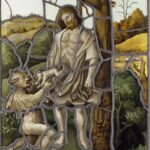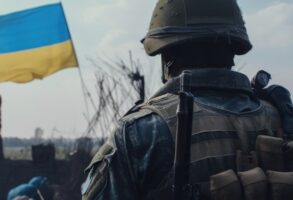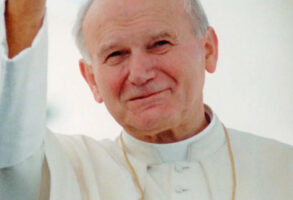Published September 18, 2017
George Weigel’s two biographies of St. John Paul II—Witness to Hope and The End and the Beginning—are widely considered the authoritative volumes on the life and work of the Polish pope. Weigel has a new book out, Lessons in Hope: My Unexpected Life with St. John Paul II (Basic Books), which focuses on his decades-long friendship with St. John Paul and on the inspiring witness the pope offered the world in the face of great suffering in the last years of his life.
Weigel recently spoke to CWR editor Carl E. Olson about his new book.
Carl E. Olson, for CWR: At the start of Lessons in Hope, you note that you thought Witness to Hope and The End and the Beginning, which totaled about 1,600 pages, contained all you could or would say about St. John Paul II. Why this third book? In what ways is this “album of memories,” as you describe it, different from the two biographies?
George Weigel: Lessons in Hope is almost entirely anecdotal; it tells the stories that wouldn’t have “fit” into two volumes of biography, but that illuminate, in one way or another, interesting facets of John Paul II’s personality and way of conducting the papacy. I’ve discovered in recent years that this is what people want, now: not so much analysis of a remarkable personality and his accomplishment, but story-telling that brings him alive in a personal way.
CWR: You write that the “experience of learning John Paul II and his life taught me a new way of looking at events in my own life…” What are some examples of that? And what are some of the events that paved the way for you to become John Paul II’s biographer?
Weigel: At Fatima in 1983, one year after the assassination attempt that came within a few millimeters of taking his life, John Paul said, “In the designs of Providence, there are no mere coincidences.” What we think of as “coincidence,” or just happenstance or randomness, is actually a part of God’s providential guidance of history that we just don’t understand yet. That insight of his helped me to see how, for example, my philosophical and theological studies in college and graduate school, my work as a columnist and essayist, the people I met at the Woodrow Wilson International Center for Scholars in 1984-85, and a week in Moscow in 1990 fomenting nonviolent revolution were all providential experiences that prepared me to take on the job of being John Paul II’s biographer.
CWR: One point made in several places is the importance of understanding John Paul II’s philosophical perspective and project. What are some key features of his philosophical work? And how has this been either misunderstood or even misrepresented?
Weigel: John Paul II is persistently misunderstood as some sort of pre-modern mind, when in fact his was a thoroughly modern mind with a distinctive critique of modernity. At the heart of that critique was the conviction that ethics had come unglued from reality; that the moral life was wasting away into subjectivism and sentimentality; and that human beings (and society) were suffering as a result. The entire philosophical project he and his colleagues at the Catholic University of Lublin launched in the 1950s was an attempt to get the moral life back on a sound footing: not from top down but from bottom up—through a rigorous and compelling theory of the human person, our capacity for responsibility, and the dynamics of our moral decision-making. That’s why his philosophical masterwork was called “Person and Act.”
CWR: How did you first meet John Paul II and how did your friendship develop?
Weigel: Our first real conversation was in September 1992, when I gave him a signed copy of The Final Revolution: The Resistance Church and the Collapse of Communism, which he had already read on galley proof. Things snowballed after that, both in terms of personal conversations and correspondence, and both conversation and correspondence continued after the publication of Witness to Hope. The details of how our relationship evolved over the course of my preparing Witness to Hope and afterwards—during the dramas of the Long Lent of 2002, the Iraq War, and his last illness—are described in detail in Lessons in Hope.
CWR: John Paul II strongly encouraged you to meet with many of his friends from his time in university. Why was that so significant to him? How did that period of time shape the rest of his life?
Weigel: It was not so much his friends from his own time in university (although I did meet with the surviving members of his underground wartime theatrical troupe, the Rhapsodic Theater), but the friends he made while he was a university chaplain in the late 1940s and early 1950s. As he was helping form them into mature Catholic adults, they were helping form him into one of the most dynamic and creative priests of his generation. He thought that story was crucial to understanding him “from the inside,” so he encouraged me to talk with these men and women, several of whom are now close friends of mine.
CWR: You emphasize, as you have many times over the years, that your two biographies of John Paul II were not “authorized biographies.” What does that mean and why is it so important?
Weigel: An “authorized biography,” in the usual sense of the term, is one that has been vetted (and perhaps edited) by the subject or the subject’s heirs, in exchange for access and documents; so an authorized biography should be read with a certain reserve, given what one has to assume was the vetting involved. At the very outset of the Witness to Hope project, I told John Paul over dinner that he couldn’t see a word of what I wrote until I gave him the finished copy of the book, and he immediately responded, “That’s obvious.” He knew, as I knew, that there could be no one looking over my shoulder as I wrote if the book was to be credible; he also thought that the book was my responsibility and he wasn’t about to change a lifelong pastoral habit of challenging others to be responsible without imposing his own judgments. So while I hope Witness to Hope and The End and the Beginning are as authoritative as possible, they are in no sense “authorized.” I also hope that Lessons in Hope ends, once and for all, the urban legend that John Paul II asked me to write his biography. He didn’t. I suggested the project and he agreed to cooperate with it.
CWR: What were some of the more challenging aspects of researching the life of John Paul II?
Weigel: There were a lot of people in the Roman Curia who weren’t as eager for me to have full access to people and documents as John Paul II was, and the stories of my adventures in getting through that Italianiate obstacle course are very much part of Lessons in Hope. Then there were the problems posed by my predecessors in the papal biographers’ guild, like Tad Szulc and Carl Bernstein: people who had spoken freely with them felt that they had been burned, in the sense that Szulc and Bernstein had slotted their reflections into what these men and women who knew John Paul II well thought were nonsensical analyses. And it took a while for me to convince some of them that I was different. There was also the challenge of inviting a man with a deep sense of privacy to talk about aspects of his life he had rarely if ever discussed before; but John Paul answered every question I posed to him and in fact pushed me into exploring areas of his life to which I might otherwise have given short shrift.
CWR: In discussing the “Long Lent”—the clerical sexual abuse scandal that broke in early 2002—you explain that there existed an “information gap” between Rome and the United States. Why did that gap exist? How well or poorly was John Paul II informed of what was happening?
Weigel: The gap existed because of curial incapacity and the general Roman sense that “things can’t be as bad as all that,” which is too often applied to crises. The story of how the Pope got more fully informed of the situation, and my role in helping facilitate that, is told in detail in Lessons in Hope.
CWR: What are some lessons from John Paul II that you think are especially apt now, in 2017?
Weigel: In this time of turbulence in the Church it’s important to remember that we’re not in 1978. The growing parts of the Church throughout the world are the parts of the Church that have embraced what I’ve come to call “all-in Catholicism” as exemplified by the teaching of John Paul II and Benedict XVI, and the dying parts are those parts that continue to embrace Catholic Lite. This distinction is true of pastoral life, Catholic intellectual life, and the Church’s public witness. And that makes for a very, very different circumstance than the situation in 1978, when Catholic Lite pretty well ruled the roost. Catholic Lite is a failure and has no future; there is a compelling alternative to it, created by the Second Vatican Council as authoritatively interpreted by John Paul II; and if we all remembered that, things would be a little calmer these days.
George Weigel is Distinguished Senior Fellow of Washington, D.C.’s Ethics and Public Policy Center, where he holds the William E. Simon Chair in Catholic Studies.
Carl E. Olson is editor of Catholic World Report and Ignatius Insight. He is the author of Did Jesus Really Rise from the Dead?, Will Catholics Be “Left Behind”, co-editor/contributor to Called To Be the Children of God, co-author of The Da Vinci Hoax (Ignatius), and author of the “Catholicism” and “Priest Prophet King” Study Guides for Word on Fire. He is also a contributor to “Our Sunday Visitor” newspaper, “The Catholic Answer” magazine, “The Catholic Herald”, “National Catholic Register”, “Chronicles”, and other publications.









